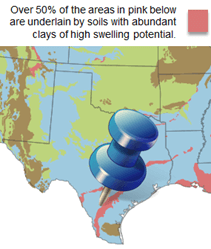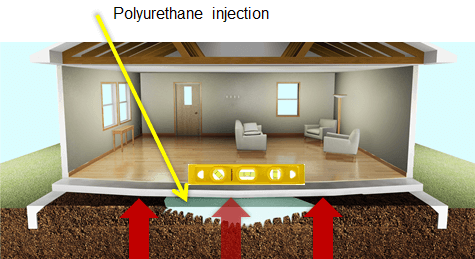The biggest cause of foundation problems in an area like San Antonio, where many homes are built on slab on-grade foundations, is a result of changing moisture levels underneath the home. Once you understand the cause, you can better determine if your foundation might be affected and get help deciding what the best method of repair is for you.
Causes of foundation problems in San Antonio
San Antonio, Texas isn’t known for its high rainfall. In fact, according to city-data.com the average rain in this part of the country barely even reaches 30″ annually. Thats only 2.5″ of rain every month on average. The relatively dry climate here can wreak havoc on your home’s foundation.
Most homes in the area are built on slab on-grade foundations. With a slab on-grade, the foundation is placed directly on top of a level soil base beneath it. For the most part, the middle of the foundation will remain moisture controlled regardless of what the weather is doing. However, the active area on the outside edge is susceptible to shifts in moisture.
How to tell if your foundation could be at risk
San Antonio is located in an area of Texas where over 50% of the soil could consist of clay with high swelling potential. What does that mean? Well, clays of this nature can be heavily impacted by moisture or the lack of it.

Then, in drought conditions, common to this part of Texas, the soil releases all of the moisture content to the dry climate. Because of the nature of clay soils a lack of moisture can cause soil to pull back from the foundation. Slab foundations of all ages can start to sink, settle or heave.
Inside the home you should look for cracking above door frames, floor cracking, or windows and doors improperly closing. Outside, pay attention to the straightness of walls and check for any cracks in the outer wall finish. Also, look for excessive cracking in the soil around the base of your exterior walls.
Repair and maintenance methods
Although moisture is the key element in most foundation issues found in Medina County, Bexar County and Comal County, there can be other problems as well. However, it’s important to remember that these other issues are often a result of, or a cause for, additional moisture problems.
Mature landscaping, trees specifically, will mean large roots. Not only will those roots take moisture out of already overtaxed soils but they can also grow directly into plumbing lines. When lines crack, more moisture is put into the ground adding to the overall problem.
To prevent foundation damage caused by tree roots, homeowners may consider installing a root barrier. A root barrier is a membrane across the foundation, that shields it from tree roots and is installed after a trench is properly dug. Drainage is another good tool that can be used to manage excessive water levels away from the home’s foundation. Even simple repairs like downspouts and extensions can prevent foundation problems.
For serious slab on-grade issues Olshan recommends pilings or concrete lifting (house leveling) depending on the need and problem that requires fixing. For example, Olshan’s Hybrid Piling System can be driven deeper than other methods even in difficult soil like the clay rich soil common in Texas.
An alternative is concrete lifting, sometimes referred to as slab raising or foam jacking. This process uses polyurethane grout instead of pilings or piers to raise the foundation back to as near built construction. The substance is pumped under the home, where the foundation meets the soil, and fills the voids between the two surfaces, lifting the the foundation upwards and helping to adjust the home to an acceptable level.
In San Antonio, slab on-grade foundations can become compromised by moisture whether too much or too little in a hurry. If you’re seeing signs of problems, schedule an assessment.

